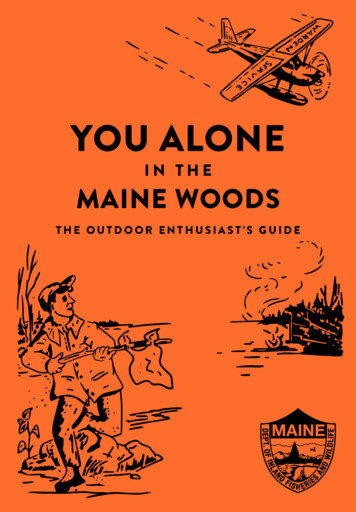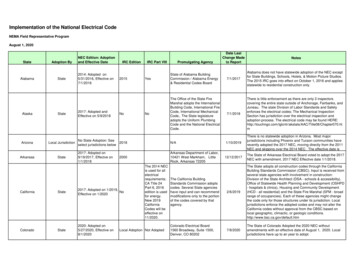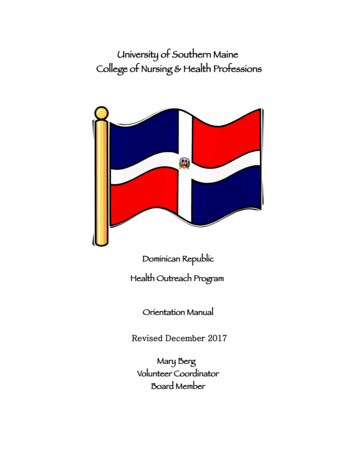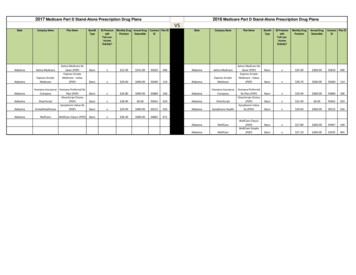
Transcription
YOU ALONEIN THEMAINE WOODSTHE OUTDOOR ENTHUSIAST’S GUIDEMAINE
This is your personal survival manual. Read it thoroughly before yourtrip into the Maine woods, and then carry it with you when you go.Name:Address:City/Town:State: Zip Code:email: phone:Medical problems, if any (include drug reactions):Blood Type:In case of accident or serious illness, please notify:Name:email: phone:
YOU ALONE IN THE MAINE WOODSA practical guide to woods comfort, safety, and survival1st Edition 1972bySafety Officer Gareth Anderson, Search & Rescue CoordinatorandCol. John F. Marsh, Maine Warden Service2nd Edition 19735th Edition 19768th Edition 19983rd Edition 19746th Edition 19799th Edition 20014th Edition 19757th Edition 198310th Edition 200311th Edition 2020byMichael F. Richard, Hunter Safety DirectorScarborough Fish and Game AssociationBrad Rounds, Maine Master GuideBryan Courtois, Education DirectorMaine Association for Search and Rescue (MASAR)andMichael Sawyer, Recreational Safety Unit Supervisor,Maine Department of Inland Fisheries and WildlifeMAINE
CONTENTSBe Prepared – Have A Survival Kit. . . . . . . . . . . . . . . . . . . . . . 2Let Someone Know . . . . . . . . . . . . . . . . . . . . . . . . . . . . . . . . . . 5Dress Smart To Maintain Normal Body Temperature . . . . . . 6Boots . . . . . . . . . . . . . . . . . . . . . . . . . . . . . . . . . . . . . . . . . . . . . 10Weather. . . . . . . . . . . . . . . . . . . . . . . . . . . . . . . . . . . . . . . . . . . . 11Map And Compass. . . . . . . . . . . . . . . . . . . . . . . . . . . . . . . . . . 12The Importance of Water in the Body. . . . . . . . . . . . . . . . . . 22Overnight Preparations. . . . . . . . . . . . . . . . . . . . . . . . . . . . . . 23Fire Is Survival. . . . . . . . . . . . . . . . . . . . . . . . . . . . . . . . . . . . . . 25Starting A Fire In The Rain. . . . . . . . . . . . . . . . . . . . . . . . . . . 28Shelters . . . . . . . . . . . . . . . . . . . . . . . . . . . . . . . . . . . . . . . . . . . 30Spending The Night. . . . . . . . . . . . . . . . . . . . . . . . . . . . . . . . . 32Play An Active Role In Your Rescue. . . . . . . . . . . . . . . . . . . . 32Tips To Keep Warm By. . . . . . . . . . . . . . . . . . . . . . . . . . . . . . . 35Signals. . . . . . . . . . . . . . . . . . . . . . . . . . . . . . . . . . . . . . . . . . . . 36Mental Control . . . . . . . . . . . . . . . . . . . . . . . . . . . . . . . . . . . . . 41Wild Foods . . . . . . . . . . . . . . . . . . . . . . . . . . . . . . . . . . . . . . . . 42Ticks. . . . . . . . . . . . . . . . . . . . . . . . . . . . . . . . . . . . . . . . . . . . . . 42First Aid. . . . . . . . . . . . . . . . . . . . . . . . . . . . . . . . . . . . . . . . . . . 44Water Safety For Outdoor Enthusiasts. . . . . . . . . . . . . . . . . 50Tips For Expeditions With Kids. . . . . . . . . . . . . . . . . . . . . . . 52And Some Final Thoughts for Special Circumstances . . . . 52
The Maine woods and waters offer endless opportunities forenjoyment — whether afoot (hunting, hiking, or snowshoeing) afloat (sailing, paddling, or powerboating), or riding onan ATV, snowmobile, or horseback.But whenever you venture out to the woods or waters, therewill be risks involved. You can’t completely avoid them, butyou can anticipate them, prepare for them, and reduce thedanger you put yourself and your fellow travelers in shouldan incident occur.Sometimes it’ll just be an oops that you learn from withoutsuffering anything more than embarrassment. Other times,your decisions and actions (or inaction) can escalate to aserious or life-threatening event.Your planning, training, outfitting (clothing and equipment), and situational awareness will make all the difference. Nature in general, while unforgiving, is not out to getyou. And animals, if respected, don’t pose a danger.You don’t need to plan, train, and equip for every worst-casescenario – just the things most likely to occur. You probablydon’t carry extra brake parts in your car, but you likely docarry a spare tire and the tools to change it. This is the sameconcept. Two-week survival situations happen, but they areextremely rare. The vast majority of folks get themselvesback to safety or are found within 24 hours; so it’s just thoseone or two unplanned days out there that you should alwaysbe ready for.1
BE PREPARED: HAVE A SURVIVAL KITWhen venturing into the Maine woods, you should alwayscarry a basic survival kit. Take good care of it, always keep iton your person, and only use it in an emergency.Its contents may vary somewhat depending upon your activity,but you should be able to create a simple version from suppliesyou already have at home or camp. Listed below are the itemsyou should always include, as well as some others that willmake you more comfortable if you ever get lost in the woods.Items to always keepon your person (and neverenter the woods without): A knife A map A compass A waterproof containerwith a lighter, sparker, orwaterproof matches (storethe striker in the samecontainer, but be sure itcannot rub against thematch heads) and firestarters such as cotton ballssoaked in petroleum jelly A plastic whistle2Additionally, your kitshould always include: A spare knife A small folding hand sawor wire-type saw, such as aflexible section of chainsawwith nylon loop handles oneach end A spare compass Personal medicine for twodays, including your choiceof over-the-counter painmedication Emergency-type survivalfood — think durable, longshelf-life, no-preparationitems like commercially-made energy bars, hardcandy, chewing gum, hotdrink mixes, etc.
Optional items to pack depending upon your activity: A copy of this booklet A space/mylar blanket or“sleeping bag” A tick removal tool:tweezers, a tick spoon,or a tick key A antiseptic wound wipes A small container of handsanitizer (you can also useit to clean wounds or starta fire) Band-Aids Three to four 4-inchindividually wrapped gauzesquares Military-style trauma dressing or a wrapped maxi pad Commercially madetourniquet if you are trainedto use one A cup or foil plate (to savespace, use a large metalnon-insulated mug. Thatway, it can double as apot to heat water in and acontainer for your “always”non-food items). Needle and thread A hunter orange vest(whether you are huntingor not)3
Optional items to pack depending upon your activity: A headlamp or flashlight with extra batteries An old CD or DVD to serve as a signal mirror A 1x2 feet sheet of aluminum foil (wraps around a pencil) Waterproof fire starters (such as wax-soaked cardboard) Safety pins Several feet of duct tape (wraps nicely around a shortenedpencil) Five or six feet of light wire or dental floss A 50-foot parachute cord Flint or metal match or disposable lighter Two plastic contractor bags (orange if you can find them) Spare glasses (if necessary) A method to purify water (a small amount of householdbleach, disinfecting tablets or liquids, or a purification straw)In addition to survival items, make sure you also have: Bug repellent (something with DEET content or Picaridin —both are proven effective for ticks) Sunscreen Two hunter orange bandannas A change of socks (wool, nylon-wool blend or an alternativethat has no cotton)These items, even in moderate amounts, will help preventhunger and create a sense of wellbeing if you become lost. Theamount of each is up to you, but most people who get losteither find their way out or are found within 24 hours. You mayadd other things, but try to keep the package small and light sothat it will always be easy to carry.4
LET SOMEONE KNOWAlong with your survival kit, you have another job beforeentering the Maine woods: let someone know where you’regoing. Plain and simple, if no one knows you went and whereyou went, no one is going to be looking for you!Leave the following information with a responsible adult whowill call 911 for help if you are overdue: What you are doing Where you are headed Who is with you A description of your vehicle and where it is located Description of your boat, snowmobile, ATV as appropriate Your latest return timeOnce you get back safely, let the responsible person know thatyou are back. Otherwise, wardens and others are going to belooking for you without reason. If you change plans, make suresomeone knows.Also, don’t hide your car. Leave it where it can be easily foundand used as a starting point for rescuers, should a search benecessary.The Warden Service is responsible for finding you in case youbecome lost in the woods. The State Police are in radio contactwith wardens, so those concerned should call 911 and they willnotify the Warden Service.5
DRESS SMART TO MAINTAIN NORMALBODY TEMPERATUREMaine guides and outdoor enthusiasts of old were aware ofthe principles of keeping the body warm. People were amazedthat their guides could stay so comfortable while seemingly solightly clad. These early guides were active individuals, whetherat play or work, and they soon found that bulky garments were ahandicap. The lesson: it’s about all about dressing in layers!Today, there are many durable fabric options for variousactivities that can be worn in layers and will: Trap air for insulation Maintain warmth even when wet Wick moisture away from your skin — an essential feature inany weather Keep wind and rain outSeveral thin layers are always warmer than one or two thick ones,and give you the flexibility to treat your clothing system like avolume control. The idea is to stay warm, but not sweat. If youare moving and generating heat, you can adjust by removing layers.The order of your layers is important: closest to your skin youshould wear a thin “wicking” layer of polypropylene or a similarsynthetic that will move moisture away from your body. Avoidcotton. Your next layer should be an insulating material that willtrap warm air. This can be wool, fleece, or something similar. Ontop of that, you’ll want to have a breathable, waterproof shelllayer such as Gore-Tex , which allows smaller vapor molecules toescape without letting larger water droplets enter.6
The Base LayerStaying comfortable and dry begins with having a base layerthat can wick moisture away from your skin. This moisturecan amount to one and a half pints of water every 12 hours.Trapped moisture can be a serious problem in a survivalsituation, as it becomes difficult to dry out before retiring forthe night. Moisture also draws heat from the body, increasingthe risk of hypothermia. As a general rule, wear syntheticunderwear (or long underwear), NOT cotton. Don’t forget thatthis includes socks. Besides NOT being cotton, socks shouldnot be too tight in your footwear. Insulation requires airspaceand wiggle room; otherwise, your feet will be cold even inmoderately chilly weather.The Insulating LayerWhen choosing your insulating material, there are a few thingsto consider. Fleece vs. wool: Both wool and fleece retain most oftheir insulating properties even when wet. Fleece dries fasterthan wool, does not absorb as much water, and is lighter andmore packable. And some of today’s better garments such asclimate-control fleece can handle perspiration buildup equal toor better than wool. The drawback of fleece is that if it comesin contact with a flame or other heat source, it will melt andcan cause a serious skin injury. Wool, on the other hand, mightsinge, but will not melt. Combining wool insulation with awaterproof poncho is a time-tested basic clothing setup. Down:Be careful with down-filled garments – they are incrediblywarm and lightweight, but lose almost all insulating abilitywhen wet and are virtually impossible to dry in the field toregain loft. Even wearing a waterproof shell over the downlayer won’t do much to help if you fall into a stream.7
8
The Shell LayerToday’s lightweight garments have a remarkable ability towithstand penetrating winds. Another great feature to look foris venting (under-arm zippers, etc.), which can save you thestep of taking a layer off. Or, for a minimalist alternative totoday’s outdoor clothing, you can wear the time-proven wooland carry a rain poncho. The poncho can be used as part ofyour shelter in an emergency, your bedroll at night, a roof whenit is raining, or something to carry water in. You can huddleunder it during a severe storm, carry a fellow person on it as astretcher between two poles, or use it as a signal cloth. A light,strong poncho can even serve as an emergency flotation deviceif you capsize — simply fold it to trap air, and dog paddle alongwith it. A final consideration with your top layer is visibility. Ifyour shell is not brightly colored, consider carrying a hunterorange vest with you whether you are hiking, snowshoeing,trail skiing, etc. These are lightweight and take hardly anyroom; yet putting one on will make you highly visible when inneed of help.HandwearLike your clothing in general, your handwear should suit theactivity. One great tactic is to wear wool, silk, or poly gloveliners under your heavier gloves or mittens. They provide a lotof dexterity when you take your main handwear off, while stilloffering some protection.9
BOOTSBoots fall into three main categories: all-rubber, all-leather orleather/fabric combinations, and rubber-bottomed, leathertopped. Whichever you choose, make sure they fit properlywith the socks you would normally wear.All-rubberThe all-rubber boot is waterproof, of course, but it has no ventilation and leaves a lot to be desired in terms of ankle support.All-leather or combination leather-fabricThese boots provide good ankle support and often havehigh-traction soles. If this type of boot seems most appropriateto you, strongly consider a pair with waterproof, breathableliners and removable insoles. Otherwise, you will need to sealthem with an agent like silicone. This will warm and waterproofthe boots, but it will also seal up all ventilation, causingmoisture buildup, which can be a serious issue in boots. Addingfelt inserts can help draw moisture away from your feet andsocks, but you’ll still need to dry them after every use.Rubber-bottomed, leather-toppedSince the rubber-bottomed, leather-topped boot allows someventilation through the leather, gives you ankle support, iswarm, adjustable, waterproof, and withstands punctures, wecan say that it has more desirable survival qualities than others.You can buy these boots with insulated bottoms for extrawarmth or with insulating insoles that you should remove anddry each night.10
WEATHERAlways check weather forecasts before going out in the woodsor on the waters. Although not as dramatic as being immersedin water, both wind and wetness (fog, rain, snow) increase bodyheat loss more than enough to be worried about. Sometimes, thebest option is to not go out at all.When you do go out, be weather-alert: pay attention to, and beprepared for: Sudden changes in temp Cloud changes (more of them,erature and wind directiongetting more packed together,or speed on your skindarker, and/or lower)Warm or clear weather can change abruptly, leading to suddenlyhigher winds, dramatic temperature drops, or intense rain,snow, or hail. For the unprepared, this can be a recipe forhypothermia!Lightning stormsEspecially in the open, above the treeline, and on the water,these are very high-risk situations. If you find yourself in one: In a boat, stay low in the craft and head for shore, preferablynot a rocky shoreline with wind-driven waves. Once ashore,seek the protection in a building, a vehicle with the windowsrolled up, or under trees of uniform height, NOT one or twotrees in an open area. In an exposed area on land, get to the protection of trees ofuniform height, NOT single trees in an open area. If that isnot possible, such as if you are above tree-line, stay away fromcaves or overhanging rock; and if with others, spread out atleast 50 feet apart. Crouch down on your pack or an insulatedpad if you have one with you, and keep trekking poles,paddles, and firearms horizontal to the ground.11
MAP AND COMPASSNow that you are prepared with a survival kit and are properlydressed to enter the Maine woods, let’s talk about the mostimportant of all your survival tools: the map and compass.First, forget any ideas you may have that map and compasswork is difficult; actually, it is pretty simple. You can becomemuch more confident with it by taking a map and compass classand practicing at home.A note on paper vs. electronic mapsPaper maps may seem old-fashioned, but small screen sizeson GPS units and mobile phones require a lot of panning andzooming to see features adequately and then to put them intoperspective. Lots of folks use e-maps at home and print whatthey want, putting it into a plastic zip-lock bag for protection.Remember: paper maps need no batteries.Topographic (Topo) MapsA topo map is an aerial drawing of an area that uses varioussymbols, lines, and colors to tell an experienced reader manyimportant things.Before setting out you should make sure that you have anaccurate, up to date map of the area you are going into. USGSmaps can be downloaded and then printed /topographic-maps. You should not rely only on an electronic mapand should carry a printed copy at least as a backup. Thereare commercially available maps such as the Maine Atlas andGazetteer as well as activity specific maps produced by the statethat cover ATV and snowmobile trails. Sources for hiking maps12
include those produced by the Appalachian Mountain Club andthe Maine Appalachian Trail Club.Topo maps use the following color scheme to highlightvarious features:Green: Forested AreasBlue: Water (Lakes, Ponds, Rivers Streams, etc.)White: Open AreasBlack: Man-Made Features (Roads, Bridges, Structures, Trails)Brown: Lines showing land contours (elevation abovesea-level all along each line)Some maps may also show revisions made using aerialphotographs in Purple.13
The Map Legend, usually found at the bottom of the map,contains other important information including:Scale: The distance across the map in kilometers, milesand feet. A scale of 1:24,000 means that one inch on themap represents an actual distance of 24,000 inches or2,000 feet.Contour Interval: the difference in feet of elevationbetween each contour lineLocation: Latitude and longitude covered, plus the nameof map and surrounding mapsMagnetic Declination – this is the difference between Trueor Geographic north, and Magnetic north in the map areaDate drawn: The date the map was drawn or compiledDate Drawn is important. Topo maps are not updatedoften; and as a result, there may be new features addedafter the date drawn that aren’t shown on the map(homes, businesses, roads, etc.), as well as things shownon the map that are no longer there (trails, structures,etc.). It’s a good idea to use a second, more current mapsource such as the DeLorme Maine Atlas or a similar toolto supplement your topo map.Contour Lines: These brown lines show theshape and height of the land features (hills,mountains, valleys, etc.). As shown in the drawing on theright, the contour lines on gentle slopes are further apartwhile those on steeper slopes are closer together. A contourinterval of 20 feet means that the hill shown in the exampleis between 80 and 100 feet in height and the gentle slope ison the western side.14
Parts of an Orienteering CompassMagnetic North vs True North: By convention, true (orgeographical) north is usually at the top of the map. Since youwill be relying on traveling by magnetic bearing, you will need away to take accurate magnetic bearings from your topo map.The easiest way to do this is to draw magnetic north/south lineson your map using its declination information (for example,18 degrees, 30 minutes West declination on the Greenville, MEtopo map). Draw your first line carefully, and then draw additional parallel lines at equal distances across the map. Note thatthe lines in the diagram slant 18.5 degrees to the left of vertical(West of true North) and are about ½ mile apart, making it easyto estimate distances across the map. They also make it easy totake magnetic compass bearings.15
To take a bearing or azimuth from point A to point B: placethe edge of your compass along the line running from point Ato Point B. Point the Direction of Travel arrow in the directionyou will be walking. Then rotate the dial until the orienteeringlines drawn on the bottom of the compass dial are parallel withthe north-south lines you have drawn on your map. Be surethat the orienting arrow in the middle of the dial points towardthe north end of the magnetic north-south lines. Note: we donot use the needle when taking the bearing in this way. Thebearing is indicated at the point where the dial touches theback (nock) end of the Direction of Travel arrow (50 degrees).16
Once you have determined your compass bearing, you willwant to follow your bearing. First, face the direction of yourcompass bearing by holding the compass in the palm of yourhand with the Direction of Travel arrow pointing away fromyour chest like a gunsight. Hold the compass flat (to allow theneedle to move freely) and slowly rotate your body until thenorth end of your compass needle comes to rest over the north(pointed) end of the orienteering arrow. You are now facing50 degrees (or whatever bearing your compass was set for).Sight down the Direction of Travel arrow and find a distinctobject (landmark) near to you and in your line of travel that youcan walk to without losing sight of it. Walk to the object, andthen repeat the process using another landmark further downyour line of travel. Repeat this procedure until you reach yourdestination or are ready to change direction.To take a bearing on an object: Place your compass flat inthe palm of your hand and point the Direction of Travel arrowat the object. Keeping the compass flat and the Direction ofTravel arrow pointed at the object, slowly turn the dial of yourcompass until the north end of the orienting arrow is directlybeneath the north end of the compass needle. The bearing tothe object will be found on the dial where it touches the back(nock) end of the Direction of Travel arrow. In this example,the bearing to the “mountain” is 310 degrees. You can nowtravel following the bearing to the object using the methodabove, even if you lose sight of the object as you travel.17
To reverse your direction, simply add or subtract 180 degrees(half of a circle) from your original bearing: 50 180 130degrees. 310 – 180 120 degrees. This is known as finding yourback-bearing or back-azimuth.To Orient your map using your compass, set the map, foldedif necessary, on a flat, level surface, set the compass on themap, and turn the map until the magnetic North-South linesare aligned with the North-South arrow of your compass. Themap is now oriented. Objects around you will be in the samedirections as they appear on the map.Keep in mind that your compass needle is magnetic and willbe affected by items containing iron or steel, such as knives,firearms, vehicles, etc. if they are too close to your compass.18
Electricity also generates a magnetic field, and can affect theneedle, so be aware that electric current, cell phones, powerlines, etc. may also interfere with your compass needle if theyare close enough.Pinpointing an ObjectYou already know that it is easier to aim for a fairly large objectthan for a house, camp, etc. It is possible, however, to relocate aspecific site using the following method:By way of example, let’s say you were hunting and have shot amoose that you can’t haul out without help.First, blaze a large circle about him and maybe tie pieces ofyour bandanna or flagging tape around the area. From yourknowledge of the lay of the land (because you’ve studied yourarea map), you know a good hauling road is nearby, directlynorth. So, you take a north bearing of 0 degrees and notethe landmarks along the way. Use the landmark-to-landmarkmethod described above to travel your bearing.When you hit the road, mark the spot carefully and head backto camp for help. You can save a great deal of work in a situation like this by writing details of the trail in your notebook andeven counting steps for distance. When you go back, you willhave the return bearing all set for you.Once you have help, all you have to do is travel back following asouth bearing of 180 and all the familiar landmarks. If you stillcan’t find the moose, mark the spot where you have stoppedwith something like an orange bandanna and walk a circlearound it as far away as you can without losing sight of it. You’lllikely catch sight of one of the other markers you left aroundthe animal, and there he will be!19
By Way of ReviewTo travel about confidently and safely in the woods and fieldsof Maine, you need to follow three basic rules: 1.) Place yourcompass on the map, 2.) Set the compass by the map, and 3.)Set yourself by the compass.Map and compass skills are not rocket science. Master the fewtechniques shown above and practice them. Start in your yard,field, or nearby city park until you become confident in yourability. Only then should you head for the big woods.Protect your map from the elements by placing it in a waterproof container (such as a Zip-Lock Bag). Carry a backupcompass (or two). Once you develop confidence in your abilityto travel with a map and compass, you’ll find it so simple andenjoyable that you’ll want to use it at every opportunity.One final rule with compass work: Believe your compass. If youbegin to doubt it, look around for things that may be interfering with your needle (nearby iron objects, electricity, etc.). Takeout your backup compass(es) and compare. Take the best twoout of the three. Unless your compass is obviously broken, it isone of your most important pieces of survival equipment (yourbrain is number one).Hand-held GPSThe introduction of hand-held GPS (Global Positioning System)units has opened up the computer world to wilderness travel.These compact units are about 2x6 inches, weigh a little morethan a half a pound, and utilize several satellites circling theglobe to indicate your position on earth within a hundred yardsof your actual location.20
A GPS, when used properly, can be a valuable navigation tool,but you should never rely solely on it. Instead, maintain strongmap and compass skills and use the map and compass as yourprimary navigation tool. If you are going to use a GPS, makesure it is configured properly and that you are trained in itsproper use.It is critical to practice using your GPS in a location you’re veryfamiliar with, as you’ll need to know how to input accuratewaypoints and how to follow your particular unit. We stronglyurge you to set your GPS to show magnetic bearings; that way,you can use it with your compass for increased safety.BenefitsElectronic GPS units are great for guiding you back to locationssuch as camps, roads, and ponds; and they can theoreticallymark your trail as you venture through the woods. They’ll letyou know where you are, how fast you’re going, the direction tosteer to return home, and how much longer you have to go.The GO TO feature allows you to get back to a waypoint youhave set at your vehicle, campsite, or wherever you started. Thisis particularly useful if you have to veer off course to get arounda swamp or some other obstacle, as it will keep giving you acorrected course to get to your destination. Important note:this feature knows direction, NOT terrain. So slow down andbe very careful using it at night or during reduced visibility, asit will walk you off a cliff that during good visibility you wouldhave seen and routed around.21
DrawbacksGPS units can be expensive, they require batteries, and if youare using a GPS application on your phone, it will rely on a cellphone signal to work. No cell phone signal, no GPS. And quite abit of the Maine woods has no cell phone service.THE IMPORTANCE OF WATER IN THE BODYFor your body to function well, you must maintain a good fluidbalance. Even a 5% loss affects performance and decision-making. Drinking alcohol is NOT a way to stay hydrated; it willcause a net fluid loss and make maintaining body temperaturemore difficult. Eating snow or ice is not a good option either, asthe net loss of body temperature and related energy needed toreheat your body will likely be more than any benefit you couldgain. You need to drink water.When sourcing water outdoors, remember that clear appearance is not an indication of safe water, nor is the fact it is cold.To make water safe for drinking, you will need to boil it if youcan, or use another purification method (you should alwayshave one or more in your survival kit). Just make sure youunderstand how your water purification method works beforeyou try to use it.If you can’t purify water but you have a source, drinking waterthat might make you sick once you are back home from yoursurvival adventure is better than dehydrating at the time.22
OVERNIGHT PREPARATIONSMaybe you’re tracking an animal that you shot while hunting.Maybe you’re forty miles from nowhere riding solo on yourATV, and now you’re out of gas. Or maybe you took an off-trail“shortcut” while hiking, and you now realize it is getting alongtowards sunset.Either way, you stop to get your bearings, and slowly thatfeeling creeps over you as you realize that you have traveledquite a distance, and worse, you aren’t completely certain howto get out.Are you truly lost, or are you just turned around?Sit down and gather your thoughts. Be honest with yourself.Maybe you can hear a train, a highway, or a chainsaw. If it wereearly enough in the day, you could afford to try to find yourway out; but don’t kid yourself. If it is within an hour or soof sunset, that time
Medical problems, if any (include drug reactions): . _ phone: _ This is your personal survival manual . Read it thoroughly before your trip into the Maine woods, and then carry it with you when you go . 2nd Edition 1973 3rd Edition 1974 4 th Edition 1975










